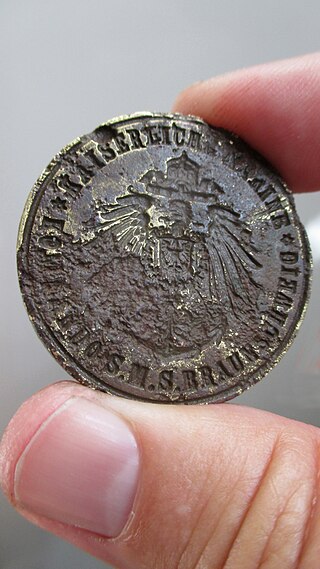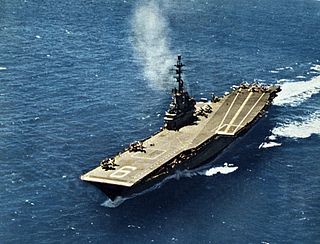There are two lists of Royal Navy ships:
- List of active Royal Navy ships lists all currently commissioned vessels in the Royal Navy.
- List of ship names of the Royal Navy lists all names that Royal Navy ships have ever borne.
There are two lists of Royal Navy ships:

The Royal Navy (RN) is the United Kingdom's naval warfare force. Although warships were used by English and Scottish kings from the early medieval period, the first major maritime engagements were fought in the Hundred Years' War against France. The modern Royal Navy traces its origins to the early 16th century; the oldest of the UK's armed services, it is consequently known as the Senior Service.
A Navy Directory, formerly the Navy List or Naval Register is an official list of naval officers, their ranks and seniority, the ships which they command or to which they are appointed, etc., that is published by the government or naval authorities of a country.

A ship prefix is a combination of letters, usually abbreviations, used in front of the name of a civilian or naval ship that has historically served numerous purposes, such as identifying the vessel's mode of propulsion, purpose, or ownership/nationality. In the modern environment, prefixes are cited inconsistently in civilian service, whereas in government service a vessel's prefix is seldom omitted due to government regulations dictating that a certain prefix be used. Today the common practice is to use a single prefix for all warships of a nation's navy, and other prefixes for auxiliaries and ships of allied services, such as coast guards. For example, the modern navy of Japan adopts the prefix "JS" – Japanese Ship. However, not all navies use prefixes. Among the blue-water navies, those of France, Brazil, China, Russia, Germany, and Spain do not use ship prefixes. NATO designations such as FS, FGS, and SPS can be used if needed.

The Royal Fleet Auxiliary (RFA) is a naval auxiliary fleet owned by the UK's Ministry of Defence. It provides logistical and operational support to the Royal Navy and Royal Marines. The RFA ensures the Royal Navy is supplied and supported by providing fuel and stores through replenishment at sea, transporting Royal Marines and British Army personnel, providing medical care and transporting equipment and essentials around the world. In addition the RFA acts independently providing humanitarian aid, counter piracy and counter narcotic patrols together with assisting the Royal Navy in preventing conflict and securing international trade. They are a uniformed civilian branch of the Royal Navy staffed by British merchant sailors.

HisMajesty's Ship, abbreviated HMS and H.M.S., is the ship prefix used for ships of the navy in some monarchies. Derived terms such as HMAS and equivalents in other languages such as SMS are used.

In the 18th century and most of the 19th, a sloop-of-war in the Royal Navy was a warship with a single gun deck that carried up to eighteen guns. The rating system covered all vessels with 20 guns and above; thus, the term sloop-of-war encompassed all the unrated combat vessels, including the very small gun-brigs and cutters. In technical terms, even the more specialised bomb vessels and fireships were classed as sloops-of-war, and in practice these were employed in the sloop role when not carrying out their specialised functions.

A scout cruiser was a type of warship of the early 20th century, which were smaller, faster, more lightly armed and armoured than protected cruisers or light cruisers, but larger than contemporary destroyers. Intended for fleet scouting duties and acting as a flotilla leader, a scout cruiser was typically armed with six to ten destroyer-type guns of 3-inch to 4.7-inch calibre, plus two to four torpedo tubes.

The lead ship, name ship, or class leader is the first of a series or class of ships all constructed according to the same general design. The term is applicable to naval ships and large civilian vessels.
These lists of Liberty ships are sortable lists, allowing ships to be looked up by hull number. Liberty ships were a type of mass-produced cargo ship built to meet inexpensively the United States's World War II maritime transport needs.

His Majesty's Naval Service is the United Kingdom's naval warfare and maritime service. It consists of the Royal Navy, Royal Marines, Royal Fleet Auxiliary, Royal Naval Reserve, Royal Marines Reserve and Naval Careers Service. The term Naval Service should be distinguished from the "UK Naval Services", which consist of the Naval Service and the Merchant Navy. The Naval Service as a whole falls under the command of the Navy Board, which is headed by the First Sea Lord. This position is currently held by Admiral Sir Ben Key. The Defence Council delegates administration of the Naval Service to the Admiralty Board, chaired by the Secretary of State for Defence.

The Ton class were coastal minesweepers built in the 1950s for the Royal Navy, but also used by other navies such as the South African Navy and the Royal Australian Navy. They were intended to meet the threat of seabed mines laid in shallow coastal waters, rivers, ports and harbours, a task for which the existing ocean-going minesweepers of the Algerine-class were not suited.

Surface ships form one of the five fighting arms of the Royal Navy.

The S class was a class of 67 destroyers ordered for the Royal Navy in 1917 under the 11th and 12th Emergency War Programmes. They saw active service in the last months of the First World War and in the Russian and Irish Civil Wars during the early 1920s. Most were relegated to the reserve by the mid-1920s and subsequently scrapped under the terms of the London Naval Treaty. Eleven survivors saw much action during the Second World War.
Lists of ships include: